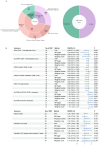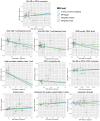Understanding bladder cancer risk: Mendelian randomization analysis of immune cell and inflammatory factor influence
- PMID: 39450166
- PMCID: PMC11499096
- DOI: 10.3389/fimmu.2024.1460275
Understanding bladder cancer risk: Mendelian randomization analysis of immune cell and inflammatory factor influence
Abstract
Introduction: The intricate roles of immune cells and inflammatory factors in cancer, particularly their association with the risk of bladder cancer, are not well understood.
Methods: This study aimed to clarify potential causal relationships between these elements and the development of bladder cancer using genome-wide association study (GWAS) summary statistics for 731 immune cell phenotypes and 91 circulating inflammatory factors (cases=2,053; controls=287,137). The primary analytical approach was Inverse Variance Weighting (IVW), supplemented by MR-Egger regression, weighted median, and weighted mode analyses. Sensitivity analyses included Cochran Q test, MR-Egger intercept test, and Leave-one-out test.
Results: The findings indicated that monocytes are positively correlated with an increased risk of bladder cancer. On the contrary, double-negative (DN) T cells, HLA DR+CD8br, and CD28 on CD28+CD45RA+CD8br T cells exhibited an inverse correlation, suggesting a possible protective effect. Furthermore, inflammatory factors IL-20, IL-22RA1, and Eotaxin were significantly associated with an increased risk of bladder cancer.
Discussion: These results suggest that certain immune cell phenotypes and inflammatory factors may play a role in the development of bladder cancer and could serve as potential biomarkers for assessing tumor risk. The findings also offer new insights into the pathogenesis of bladder cancer, indicating a need for further investigation.
Keywords: GWAS; Mendelian randomization; bladder cancer; immune cell phenotypes; inflammatory factors.
Copyright © 2024 Un, Wusimanjiang, Zhan, Zhang, Li, Lei, Lin, Zhang, Chen and Wang.
Conflict of interest statement
The authors declare that the research was conducted in the absence of any commercial or financial relationships that could be construed as a potential conflict of interest. The reviewer XD declared a shared parent affiliation, with no collaboration, with the authors to the handling editor at the time of the review.
Figures




Similar articles
-
Causality of immune cells and endometriosis: a bidirectional mendelian randomization study.BMC Womens Health. 2024 Oct 26;24(1):574. doi: 10.1186/s12905-024-03417-0. BMC Womens Health. 2024. PMID: 39462363 Free PMC article.
-
Plasma metabolites as mediators in immune cell-pancreatic cancer risk: insights from Mendelian randomization.Front Immunol. 2024 Jun 12;15:1402113. doi: 10.3389/fimmu.2024.1402113. eCollection 2024. Front Immunol. 2024. PMID: 38933268 Free PMC article.
-
The genetic relationships between immune cell traits, circulating inflammatory proteins and preeclampsia/eclampsia.Front Immunol. 2024 May 30;15:1389843. doi: 10.3389/fimmu.2024.1389843. eCollection 2024. Front Immunol. 2024. PMID: 38873604 Free PMC article.
-
[Inflammatory factors and prostate cancer: Two-sample Mendelian randomization analysis].Zhonghua Nan Ke Xue. 2024 Jul;30(7):588-596. Zhonghua Nan Ke Xue. 2024. PMID: 39212392 Chinese.
-
A Mendelian randomization study investigating the causal relationships between inflammation and immunoglobulin A nephropathy.Hum Immunol. 2024 Jul;85(4):110830. doi: 10.1016/j.humimm.2024.110830. Epub 2024 Jun 10. Hum Immunol. 2024. PMID: 38861759
Cited by
-
Mendelian randomization analysis of gut microbiota-immune cell interactions in malignant neoplasm of nasopharynx.AMB Express. 2025 Jul 15;15(1):106. doi: 10.1186/s13568-025-01909-2. AMB Express. 2025. PMID: 40663222 Free PMC article.
-
Evaluating the Causal Role of Genetically Inferred Immune Cells and Inflammatory Cytokines on Myalgic Encephalomyelitis/Chronic Fatigue Syndrome.Biomedicines. 2025 May 15;13(5):1200. doi: 10.3390/biomedicines13051200. Biomedicines. 2025. PMID: 40427027 Free PMC article.
References
MeSH terms
Substances
LinkOut - more resources
Full Text Sources
Medical
Research Materials

